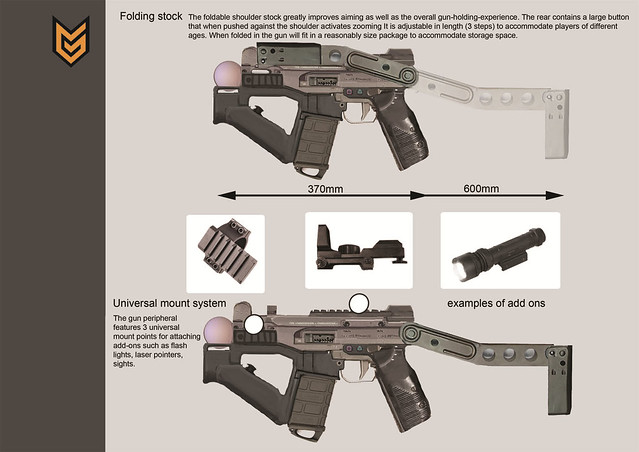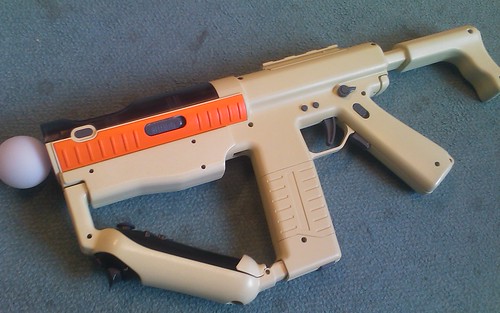In part one of our look at the origins of the PlayStation Move sharp shooter, we saw how the peripheral began life as a side project at Guerrilla. In the second part, we learn how the Guerrilla team received valuable help from their friends at Zipper Interactive.
Guerrilla’s proposal for a Move-based peripheral was sent to SCE Worldwide Studios President Shuhei Yoshida and the Sony Product Design group, who circulated it among other studios for input. The proposal met with very enthusiastic reactions. “When we saw the foam-board-and-duct-tape mockup, we were like ‘Cool, let’s make that!’” Sony Product Design Manager Ennin Huang recalls.
It wasn’t long before Guerrilla was contacted by developers from other shooters like SOCOM 4, Time Crisis: Razing Storm and Dead Space: Extraction. Zipper Interactive Game Director Seth Luisi, who’d already been looking into a PlayStation Move-based control scheme for SOCOM 4, took a particular interest in the project. “Seth strongly felt that a gun peripheral could bring an additional level of immersion and realism to the table,” Guerrilla Game Director Mathijs de Jonge says. “Like Killzone 3, SOCOM 4 was still in its early stages, so the timing made sense for him as well.”

With each iteration, the design evolved away from the StA-11.
The Zipper team suggested several highly useful additions to the gun peripheral design. “For instance, they wanted players to be able to reload without taking their hands off the navigation controller,” Mathijs explains. “This could be solved by adding pump-action mechanism to the fore grip. Also, they noted that many tactical shooters, including SOCOM 4, featured weapons with multiple modes of fire, which would require the inclusion of a fire selector switch.”

With basic shape and functionality hammered out, the gun peripheral entered the prototyping phase. “Every six weeks, a new plastic gun peripheral would arrive from China for us and the team at Zipper to comment on,” Guerrilla Lead Concept Designer (and resident weapons expert) Roy Postma says. “And with each iteration, you could see the design come into its own more. The style of the weapon became more neutral, less Killzone-specific.”
Enhancements included a more ergonomic angle for the fore grip, an adjustable and collapsible stock instead of the foldable one, and overall weight reductions to facilitate prolonged play. “Sadly, some features fell by the wayside during this process,” Roy says. “We originally wanted to have an ammo counter display above the stock, but it just proved too costly.”
The color of the weapon changed too, evolving from the gunmetal grays of the original design, to a jet black version, to the more neutral grays of the final product. “From a legal and marketing perspective we had to impose some constraints,” Ennin says. “The black version looked menacing, but would have violated most countries’ gun laws.” Even the first grey prototypes proved difficult to get through customs, as Mathijs found after a demonstration at a conference.
Meanwhile, the teams at Guerrilla and Zipper experimented with Move control systems for their respective games, figuring out sensible settings for dead zone, aim assistance and controller sensitivity. “Initially we wanted to map a lot of in-game actions to player gestures as well,” Mathijs says, “but that turned out to interfere with player aim too much. So we restricted it to short, simple movements like thrusting the gun peripheral to perform a melee.”

The final production prototype in all its glory.
The gun peripheral went into full production in the run-up to Killzone 3’s launch. Early hands-on reports of the device – now dubbed the PlayStation Move sharp shooter – were almost unanimously positive, with many reporters expressing pleasant surprise at how solid and natural the peripheral felt during play.
“In terms of control methods, nothing feels more natural than the sheer simplicity of ‘Point, Aim, Shoot’”, Ennin says. Mathijs concurs: “The peripheral made Killzone 3 immediately accessible to people who had never played a Killzone title before. Some reporters even stated that they preferred to play Killzone 3 with the sharp shooter instead of the DualShock 3, because they felt more immersed. That was a huge compliment for us.”
But it wasn’t until the week before Killzone 3’s release that Mathijs realized his other goal for the sharp shooter had also been achieved. “I was watching the PlayStation commercial for Killzone 3 and the sharp shooter and I suddenly realized, you know what – Kevin Butler looks absolutely badass holding that thing! That’s when I knew we’d fully achieved what we set out to do.”
The sharp shooter is available now as a standalone accessory and as part of the SOCOM 4 Full Deployment Edition.
